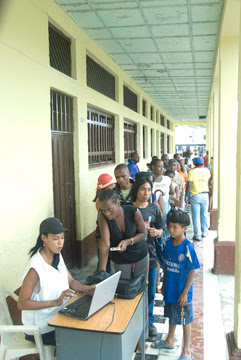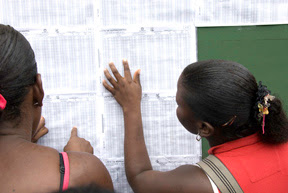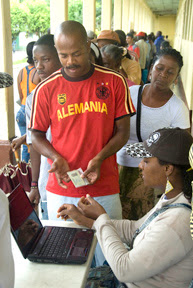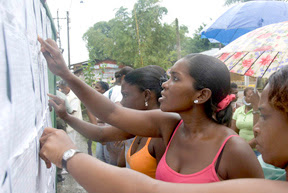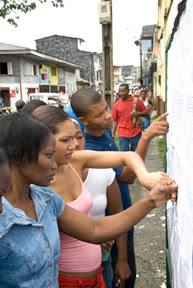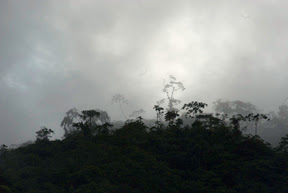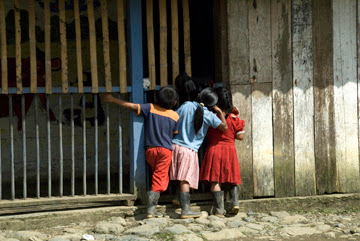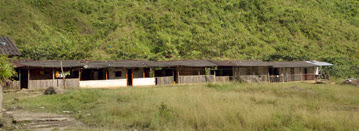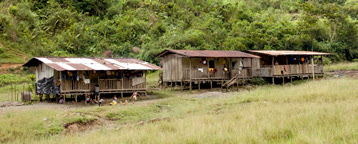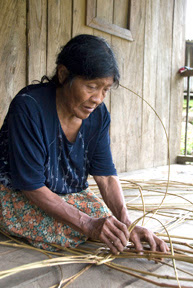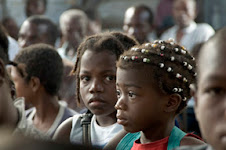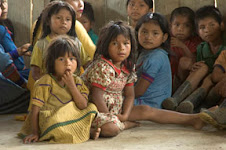(I’m in El Chocó and Colombia as a photographer, not as a writer, so it may seem a little ironic that I don’t have any pictures of the area and the people I’m describing in these entries. But I’m simply falling behind in processing the many pictures I’m taking, and even more so since I have been spending major time on the activities of the Fiesta de San Pacho since returning to Quibdó—more on San Pacho will be coming soon—well, relatively soon. As soon as I can, I’ll add some pictures of Guaduas and the Guadueños.
Estoy en Colombia y El Chocó como fotógrafo, no como escritor, por el cual puede parecer algo irónico que no he puesto fotos de la zona y la gente que describo en estas entradas. Pero la simple verdad es que me estoy atrasando en procesar las muchas fotos que estoy sacando, y aún más por cometer mucho tiempo a las actividades de las Fiestas San Pacho desde que volví a Quibdo—más sobre San Pacho viene pronto—pues relativamente pronto. En cuanto pueda, agrego unas fotos de Guaduas y los guadueños.)
Crying for Emma LazarusSometimes, something happens to help you realize how just below the surface emotions are building up. I just returned from a ten-day visit to the municipio of El Carmen de Atrato—the main mission was a five-day visit to the vereda of Guaduas—part of a commission of the Diocese of Quibdó. Part of our mission, and my primary task, was to help launch a program of recovering historical memory. This is a large part of what I’m doing in Colombia on this visit.
Guaduas is a fascinating place, with a moving 130-year history that in the last nearly twenty years includes violence at the hands of all the armed groups, displacement of the entire community in 1998 (one of the first massive forced displacements in the history of the current conflict), and now a process of returning. It’s a painful, difficult and moving history, and the Guadueños are impressive people, hard-working, welcoming and optimistic.
I intend to write more about this community, but for the moment, I’ll just tell this story:
One day we walked a couple of hours up one of the mountains, to visit one family in their provisional house, and look at the ruins of other places—all had been burned by the paramilitaries in 1998.
At the house of the people we were visiting, one of the diocesan workers asked me about the Statue of Liberty. I told them about the collection to build the base, and I talked a little about Emma Lazarus and her poem, “The New Colossus.” I’ve been thinking for a while about the relevance of that poem in light of the current anti-immigrant feelings growing in the US. I struggled a little both to remember the poem and to translate it. But halfway through, I had to quit, because I became very emotional and started to cry—the poem had released a lot of feelings for the people around me that had been building up in me these days…
Llorar por Emma LazarusA veces algo sucede que te ayuda dar cuenta como apenas debajo de la superficie están creciendo. Acabo de volver de una visita de diez días al municipio de El Carmen de Atrato—la misión central fue una visita a la vereda de Guaduas por cinco días—como miembro de una comisión de la Diócesis de Quibdó. Parte de nuestra misión, y mi tarea principal, fue ayudar en arrancar un programa de rescate de memoria histórica. Esto es parte importante de lo que estoy haciendo en Colombia durante esta visita.
Guaduas es un lugar fascinante, con una historia conmovedor de 130 años la cual en los últimos casi incluye violencia por parte de todos los grupos armados, desplazamiento de la comunidad entera en 1998 (uno de los primeros desplazamientos forzados masivos en la historia del conflicto actual), y ahora proceso de retorno. Es una historia dolorosa, difícil y conmovedor, y los guadueños son gente impresionante, trabajadora, acogedora y optimista.
Espero escribir más sobre esta comunidad, pero por el momento, solo contaré esta historia:
Un día caminamos unas horas montaña arriba, para visitar una familia en su casa provisional, y observar las ruinas de otras casas—todas fueron quemadas por los paramilitares en 1998.
En la casa de la gente que visitamos, uno de los trabajadores diocesanos me pregunto sobre la Estatua de la Libertad. Les conté lo de la recolección para construir la base, y hablé un poco sobre Emma Lazarus y el poema suyo, “El Nuevo Coloso.” Ya hace rato que vengo pensando sobre la relevancia de ese poema ante el actual crecimiento de sentimientos anti-inmigrante en EEUU. Luché un poco para recordar el poema y para traducirlo. Pero a la mitad, tuve que dejar de hacerlo, como me emocioné mucho y empecé a llorar—el poema había desatado muchos sentimientos por la gente en mi alrededor que se me habían estado creciendo en estos días….
A Little About Guaduas
One of the outstanding features of Guaduas is how stunningly beautiful the place itself is. From the road between Quibdó and El Carmen (“la trocha”), you first have to cross the Río Atrato. This is not as easy as it should be, as the paracos also blew up the bridge. A wooden bridge serves provisionally, but this means that cars and trucks can’t enter. The five of us and our luggage and gear arrived in one of the old jeeps that serve as taxis in El Carmen, and a group of Guadueños with luggage and food they had bought in the town in another. There is a car on the other side, and we loaded all the luggage on top and all the people inside (a couple hanging on outside), and took off under a mountain rain for an hour’s ride over a winding mountain trail through beautiful country, until we arrived at the canyon of the Río Guaduas.
The territory of the vereda is a real paradise. A beautiful, strong, river fed by numerous equally attractive quebradas runs between a number of low mountains (we’re in the western foothills of the Andes here) covered with exuberant sub-tropical forest. In the lower areas, and moving up the mountains, are the pastures for the beef cattle that are the main economic activity of the people here (though to date few cattle have been reintroduced), as well as banana plantations, and stands of yucca, corn and fruit trees.
Guaduas was settled about 1880 by Juan María Sánchez and his wife, Eulalia Gallego. They had lots of kids, who stayed and extended the area of the vereda. They were joined by other families called Velásquez, Cano, Moncada, Cardona, Restrepo, and others. Early in the 20th Century, Afro-Colombian families from the area of the Río Capá in Medio Atrato with names like Rentería and Martínez came into the area as workers, and stayed and became part of the community.
The community of Guaduas has a strong sense of history and great feeling of unity, based in large part on the close family connections among all of them. A combination of a hard-working community and very good land resulted in a vereda that was quite successful, where most of the people lived relatively well. They were educated (schools within the vereda went to the fifth grade—one of the teachers was our host and guide during out visit—and most young people finished their studies in school in the town of El Carmen), and most families had a gasoline-powered generator at the house.
In the 1980s and 90s, the people here began to feel serious pressures as a result of the conflict. The guerrilla forces had been in the area for a long time, but in the late 90s there were conflicts between the community and the guerrillas that resulted in the guerrillas mistreating and killing two young people. This within the context of the mistreatment and pressures from the army and police, who considered the vereda a guerrilla haven. In this period in El Carmen de Atrato, having the family name of Sánchez was reason enough to be abused or arrested by the police.
By the late 90´s, the situation in the area had become critical. Along the trocha, families (primarily mestizos and Afro-Colombians) were directly threatened by the increasing numbers of paramilitaries, or felt they had no choice but to leave. There were many deaths and disappearances in the area. In mid-1998, the Embera-Chamí community of Sabaleta was forced to move as a group to the town of El Carmen for six months (I expect to visit Sabaleta in the near future).
In the same year, human rights workers of the Diocese of Quibdó learned that the paramilitaries were planning to go through Guaduas and massacre the residents. As a result of the tensions, some people had left in the previous period, but now the diocese organized a massive evacuation of the community, not an easy task in an area where families live dispersed throughout the mountains. But it was accomplished, and doubtless saved many lives. The paracos moved through the vereda to drive out the guerrillas, and in the process killed the handful of people who had not left, as well as burning all the houses they could and killing the horses, mules and cattle left behind.
About three years ago, people started to return in an organized way. The tasks were enormous—the houses had been destroyed, the pastures were overgrown by weeds and trees up to about 8-9 feet, the internal road was gone, the bridge connecting them to the main road had been destroyed. At first, just a few people moved back, sometimes just the parents of a family, or even just the husband/father, while the rest of the family spent most of their time in town, working and going to school.
The return was not something that happened willy-nilly, but the result of serious planning. Help was sought and found for rebuilding houses, though the programs are moving slowly and encounter some obstacles—a major one is the bridge, which is necessary to move construction materials into the area.
Early in the process, diocesan workers suggested to the people that they create a caserío—a group of houses—rather than rebuilding houses scattered throughout the mountains. This would have made the process of rebuilding a lot easier, but it was rejected by the people. They wanted to return to their history, their culture, of living as family units on their fincas, near their animals. On the one hand, living in a caserío would have meant a daily trip up to the fincas to tend to the animals, milk the dairy cows, and carry out whatever other work was necessary. And on the other hand, they prefer the tranquility and solitude of living out on their own land, not close to other people. From most of the houses we visited, you can see another house off in the distance, but not from all of them.
But this does mean that to get to most of the houses, you have to walk long distances, mostly over mountain tracks and through mud and muck. And as I said to one women who lives in an isolated house not even near the internal road, this means that every pound of rice, every piece of lumber, every tool, has to be carried, sometimes on mule- or horse-back, but often on human shoulders, all the way up to the house. Yes, she agreed, but it’s worth it to us.
Un Poco Sobre GuaduasUno de los aspectos sobresalientes de Guaduas es que el lugar en si tiene una belleza asombradora. Desde el camino entre Quibdo y El Carmen (“la trocha”), primero tienes que cruzar el Río Atrato. Esto no es lo fácil que debe de ser, ya que los paracos también volaron el puente. Hay un puente de madera que sirve provisionalmente, pero esto quiere decir que no pueden entrar carros o camiones. Los cinco de nosotros/as, con les maletas y equipos, llegamos en uno de los viejos Willys que trabajan como taxis en El Carmen, y un grupo de guadueños con su equipaje y alimentos que habían comprado en el pueblo llegaron en otro. Hay un carro en el otro lado, y cargamos todo el equipaje en la parilla y todas las gentes adentro (pues, unos colgados), y arrancamos bajo una lluvia de la montaña por un viaje de una hora en un camino sinuoso de la montaña, por un escenario campestre bello, hasta llegar al cañón del Río Guaduas.
El territorio de la vereda es un verdadero paraíso. Un río bonito y fuerte, alimentado por numerosas quebradas iguales de atractivas corre entre unas montañas bajas (aquí estamos en las faldas occidentales de los Andes) y cubiertas de una selva sub-tropical exuberante. En las bajadas, y subiendo las montañas, hay potreros para los reces de engorde que son la principal actividad económica para la gente acá (aunque hasta la fecha pocos reces han sido reintroducidos), además de platanales y siembras de yuca y maíz, y frutales.
Guaduas fue fundada alrededor de 1880 por Juan María Sánchez y su esposa Eulalia Gallego. Tuvieron muchos hijos, que se quedaron y extendieron el área de la vereda. A ellos se unieron otras familias con apellidos como Velásquez, Cano, Moncada, Cardona, Restrepo, entre otros. En principios del siglo XX, familias afro-colombianos de la zona del Río Capá en Medio Atrato con apellidos como Rentería y Martínez subieron a la zona como trabajadores, y se quedaron y se hicieron parte de la comunidad.
La comunidad de Guaduas tiene un sentido fuerte de la historia y un gran sentimiento de unidad, basados en gran parte en los lazos familiares cercanos entre todos. Una combinación de una comunidad muy trabajadora y tierra muy buena dio por resultado una vereda que fue bastante exitosa, donde la mayoría de la gente vivía relativamente bien. Eran educados (las escuelas dentro de la vereda enseñaron hasta quinto grado—uno de los profesores era anfitrión y guía nuestro durante la visita—y la mayoría de los jóvenes terminaron sus estudios en el pueblo de El Carmen), y la mayoría de las familias tenían plantas eléctricas a la casa.
En los años 80 y 90, la gente acá empezó a sentir presiones serias como resultado del conflicto. La guerrilla había estado en la zona ya hacía tiempo, pero en finales de los 90 hubo conflictos entre la comunidad y la guerrilla que terminaron en que la guerrilla maltratara y matara a dos jóvenes. Eso dentro del contexto del maltrato y presiones del ejército y la policía, quiénes vieron a la vereda como asilo guerrillero. En este período en El Carmen de Atrato bastaba con llevar el apellido de Sánchez par que la policía abusara o arrestara a uno.
En los finales de los 90, la situación se había vuelto crítica. En la trocha, familias (generalmente mestizas y afro-colombianas) o recibieron amenazas directas de parte de las cantidades crecientes de paramilitares, o sentían que no les quedaba más alternativa que salir. Hubo muchos muertos y desaparecidos en la zona. En medianos de 1998 la comunidad embera-chamí de Sabaleta se vieron obligados a desplazarse en comunidad al pueblo de El Carmen por seis meses (espero visitar a Sabaleta pronto).
En el mismo año, trabajadores de derechos humanos en la Diócesis de Quibdo se dieron cuenta que los paracos tenían planes de andar por Guaduas y masacrar a los habitantes. Como resultado de las presiones, algunas personas se habían ido previamente, pero ahora la diócesis organizó una evacuación masiva de la comunidad, cosa nada fácil en un área donde las familias viven dispersas por la montaña. Pero se logró, y sin duda se salvaron muchas vidas. Los paracos pasaron a través de la vereda para correr a la guerrilla, y al hacerlo mataron a las pocas personas que no habían salido, además de quemar todas las casas que podían y matar a las bestias y ganado que se habían quedado.
Hace aproximadamente tres años, la gente empezó a retornar de manera organizada. La tareas eran tremendas—las casa se habían destruidos, los potreros llenos de monte y árboles hasta 3 metros de altura, la carretera interna se había perdido, el puente que había sido el lazo con la carretera principal se había destruido. En un principio, solo retornaron unas pocas personas, a veces solo los padres de una familia, o incluso solo el esposo/padre, mientras el resto de la familia paso la mayoría de su tiempo en el pueblo, trabajando y estudiando.
El retorno no sucedió así no más, sino que fue resultado de planes serios. Se buscó y se encontró apoyo para la reconstrucción de las casas, aunque los programas se adelantan muy lentos y encuentran unos obstáculos—uno muy grande es el puente, que les hace falta para llevar materiales de construcción a la zona.
Temprano en el proceso, trabajadores diocesanos sugirieron que se crease un caserío en lugar de reconstruir casa regadas por la montaña. Eso habría hecho el proceso de reconstrucción más ágil, pero fue rechazado por la gente. Querían volver a su historia, a su cultura, de vivir en familia en sus fincas, cerca a los animales. Por un lado, vivir en caserío habría hecho necesario ir todos los días a los fincas para cuidar los animales, ordeñar las vacas lecheras, y realizar cualquier otro trabajo que fuera necesario. Y por otro lado, prefieren la tranquilidad y la soledad de vivir en tierra propia, y no estar cerca de la demás gente. Desde la mayoría de las casa que visitamos, puedes ver otra casa allá lejos, pero no desde todas.
Sin embargo, efectivamente quiere decir que para llegar a la mayoría de las casas, debes caminar largas distancias, mas que nada por senderos de la montaña y a través de bastante pantano y barro. Y como decía yo a una señora que vive en una casa aislada, ni siquiera cerca de la carretera interna, eso quiere decir que cada libra de arroz, cada tabla de madera, cada herramienta debe subirse, a veces sobre mula o caballo, pero muchas veces sobre hombros humanos, todo el trecho a la casa. Sí, dijo, pero para nosotros vale la pena.
More on food—and vitaminsI’ve been meaning to write some more about food—including my own diet here—and the visit to Guaduas provides an occasion. One of the real treats here is arepa de choclo (or chocolo—both forms exist) con quesito. Arepa is very similar to what in Mexico, or even more in Central America would be called a tortilla, though it comes in more varieties—sometimes it’s like a small bread, other times it’s deep fried. I’ve had arepas in Venezuela and Colombia; I don’t know if they are part of other Andean cultures.
The normal arepa here is made with a fine corn dough, like the dough of Central American tortillas, usually made flat and round, the size of a salad plate, though sometimes as a small ball. It commonly accompanies any meal, though especially breakfast. The arepa de choclo is made from a coarse dough—really it’s only corn kernels ground once and kneaded with a little water and a little sugar, like corn muffins in the states, then grilled with a little oil. It has a rich sweet corn taste. I’ve had a version of them in Quibdó, and that version is very common on the streets of Bogotá, smaller and usually with a melted cheese filling. But none have been as delicious as the Guadense arepa de choclo.
Quesito is a mild, light white cheese. I’ve had both homemade and commercial quesito in Guaguas, made without the excess salt that—for me—ruins too much of the cheese here (the truth is, I’ve seen women in Quibdó buying cheese and interrogating the vendors about whether the cheese is too salty). A breakfast of arepa de choclo and quesito, accompanied by coffee, black (which is called “tinto” (ink) in Colombia) or with milk fresh from the cow, or hot chocolate or agua panela (hot water in which has been dissolved panela—blocks of raw sugar) is a real treat.
From El Carmen de Atrato, to get to the house where your lumpen food critic woke up to among other things have such a breakfast you’ll have to take two car rides over terrible roads, more than 2 hours together, (crossing the provisional bridge over the Río Atrato on foot to get from one to the other) then another 2 hour walk or so over dirt road, mountain track and a lot of mud—but it’s worth it. (Of course, I had the same meal a couple of days later with Guadueños here in El Carmen, so I guess you might be able to skip the travel, but you’ll really be missing something.)
While I’m on the topic of food, here’s a question for nutritionists out there. My experience here is raising serious doubts about the role of vegetables in the diet. The people in Guaduas (like most of my friends in Quibdó, El Carmen or Bogotá)—who are healthy and very strong, with glowing skin ands hair and beautiful teeth, who walk the mountain tracks up and down twice as fast as I, all of this at least into their 60s and 70s, and some beyond—rarely eat vegetables. Their basic diet is: potatoes, yucca, bananas both green and ripe, corn, white rice, sugar, milk, some fruit (especially guava and citrus), a little meat and chicken and occasional eggs or beans. There is some variety, but that’s basically it.
The variety? Onions are grown everywhere, and are basically used a flavoring, along with some other herbs. Carrots and cabbage are sometimes grated into a very tasty salad, sometimes with some tomato slices, especially to accompany the equally delicious sancocho—essentially a soup of potatoes, yucca, bananas, and meat or chicken—but people don’t have sancocho every day, so they get substantially less than a portion of vegetables a day on average. And green vegetables are rarely seen. Since we’re further from the big rivers and the coast, there’s little in the way of fish, though they fish with hook and line for sabaleta in the river (they use the eggs of wasps that make their nests at the houses for bait, so the wasps are tolerated). Because it was raining so much when we were there, there was no fishing. And it seems like while we were there, the season began for ahuyama, a variety of what we would call winter squash—very big, with a nice orange meat. They’ve also appeared in Quibdó, and since I returned, I’ve had delicious soup of ahuyama a couple of times.
The food I’m describing is good; I like it a lot. And unlike other places, it isn’t all fried. But for me, the absence of vegetables is dramatic (I’ve checked the markets in El Carmen, and in truth there’s not much of a variety for sale there. But in Quibdó and much more in Bogotá, where the diet is similar—with the addition of lots of really good fish in Quibdó—there are good, relatively inexpensive vegetables available, which means of course that someone is buying them).
I’m not interested in imposing my diet on the people here, even if I could. And in fact, as I’ve said, I like the food here. But the question that stays with me is: Why aren’t the people here suffering from vitamin deficiency disorders?
Más sobre la comida—y vitaminas.He querido escribir más sobre la comida—incluso sobre mi dieta acá—y la visita a Guaduas ofrece una posibilidad. Una de las verdaderas delicias acá es arepa de choclo (o “chocolo”—las dos formas existen) con quesito. Arepa es muy parecido a lo que en México, o aún más en América Central, se llamaría una tortilla, aunque se ve en más variedades—a veces es como un pancito, otras veces es frita. He comido arepas en Venezuela y Colombia; no sé si se ven en otras culturas andinas.
La arepa común aquí es hecha con un masa fina de maíz, como la masa de tortillas centroamericanas, por lo general plana y redonda, tamaño de una platilla de ensalada, aunque a veces como una pelota pequeña. Es común como acompañamiento a cualquier comida, pero sobre todo el desayuno. En cambio, la arepa de choclo es hecha de una masa tosca—de hecho, es nada más granos de maíz molido una vez y amasada con un poco de agua y un poco de azúcar, como los “corn muffins” de EEUU, y puesto en un sartén con un poco de aceite, Tiene un sabor rico y dulce de mías. He co ido otra versión de ellas en Quibdó, y esa versión es muy común en las calles de Bogotá, meas pequeña y normalmente rellena de queso fundido. Pero ninguna ha sido tan deliciosa como la arepa de choclo guadueña.
Quesito es un queso blanco muy suave. He comido quesito comercial y casero en Guaduas, hecho sin la sal excesiva que—para mi—destruye demasiado queso por acá (de hecho, he visto a señoras en Quibdo al comprar queso interrogar a los vendedores sobre si el queso tiene demasiada sal). Un desayuno de arepa de choclo y quesito acompañado de café, o tinto o con leche directa de la vaca, o chocolate o agua panela, es una verdadera delicia.
Desde El carmen de Atrato, para llegar a la casa donde tu crítico de comida lumpen amaneció para, entre otras cosas, desayunar así, te harán falta dos viajes en carro sobre carreteras tremendas, más de 2 horas juntos (cruzando el puente provisional sobre el Río Atrato para trasladarte de uno a otro), luego caminar otras 2 horas o más sobre camino de tierra, senderos de montaña y mucho pantano—pero vale la pena. (Pues, la verdad es que comí lo mismo unos días después con unos guadueños acá en El Carmen, por eso creo que puedes hacerlo sin el viaje, pero de hecho perderás algo muy lindo).
Mientras estoy en el tema de la comida, tengo una pregunta para l@s nutricionistas que puedan leer estas palabras. De mi experiencia acá, me está surgiendo una duda seria sobre el papel de las verduras en la dieta nuestra. La gente en Guaduas (como la mayoría de mis amig@s en Quibdo, El Carmen o Bogotá)—que gozan de buena salud y son muy fuertes, con la piel y el cabello luminosos y dientes lindos, que caminan los senderos de las montañas pa’ arriba y pa’ abajo a dos veces el paso mío, todo esto por lo menos en sus 60 y 70, y algunos más allá—rara vez comen verduras. La dieta básica es: papas, yuca, plátanos y bananos tanto verdes como maduros, maíz, arroz blanco, azúcar, leche, algo de frutas (sobre todo guayaba y cítricos), un poco de carne y pollo y de vez en cuando huevos o frijoles. Hay un poco de variedad más, pero básicamente eso es.
¿La variedad? Cebollas son sembradas por todo lado, y básicamente se ocupan para un poco de sabor, juntas con otras hierbas de cocina. Zanahorias y repollos son raspado, a veces, para hacer una ensalada muy sabrosa, a veces con tajadas de tomate, sobre todo para acompañar al sancocho igualmente delicioso. Pero la gente no toma sancocho cada día, pues por promedio consume mucho menos de una porción de verduras al día. Y verduras verdes se ven muy rara vez. Como son más lejos de los ríos grandes y l costa, hay relativamente poco pescado, aunque pesan el sabaleta en el río con anzuelo (usan los huevos de una avispa que hace sus nidos en las casas por carnada, por eso toleran la presencia de las avispas). Por que llovía tanto durante nuestra estadía, no pescaron. Y parece que durante nuestra visita empezó la temporada de ahuyama, una variedad de calabaza, bastante grande, con carne anaranjada buena. Desde que volví a Quibdo han aparecido acá también, y he tomado deliciosas cremas de ahuyama un par de veces.
La comida que describo es buena; me gusta mucho. Y al contrario de otros lugares, no es puro frito. Pero a mi ver, la ausencia de verduras es dramático (he echando un vistazo los mercados en El Carmen, y de hecho no hay mucha variedad de verduras a la venta allá. Pero en Quibdo, y mucho más en Bogotá, donde la dieta es parecida—con la diferencia que hay mucho pescado realmente bueno en Quibdo—hay buenas y relativamente baratas verduras disponibles, el cual quiere decir por supuesto que alguien las está comprando).
No me interesaría imponer la dieta mía sobre la gente acá, aun si pudiera. Y de hecho, como decía, a mi me gusta la comida aquí. Pero la pregunta que se queda para mi es: ¿Por qué la gente de por acá no padece de males de deficiencias de vitaminas?

